Kickin’ off the Lillstreet Holiday Open House with plenty of wheelthrown stamped & soda-fired ornaments!
from Gary Jackson: Fire When Ready Pottery https://ift.tt/2BKNmPB
Kickin’ off the Lillstreet Holiday Open House with plenty of wheelthrown stamped & soda-fired ornaments!
Fun night at the Lillstreet Holiday Opening tonight. So many fun people to chat with.
Many of them doing some holiday shopping. Some getting gifts for others…
many getting gifts for themselves!!!
Time for round three of our 2018 BikeCraft vendor mini-profiles thanks to our friend Elly Blue from Microcosm Publishing.
Here are three more of the talented folks and interesting products you’ll find at this year’s event…
Drew Devereux – website
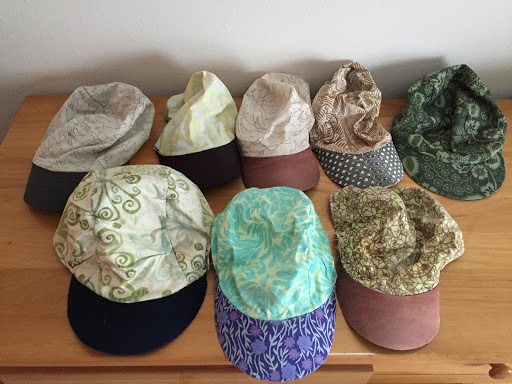
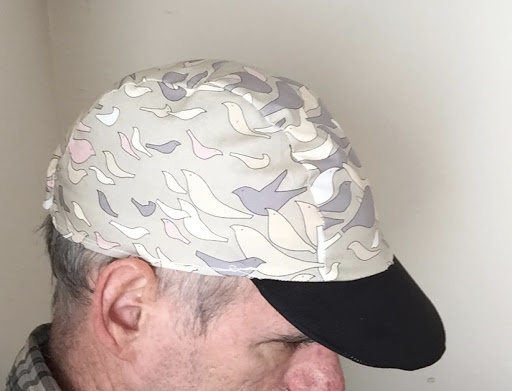
Last year’s BikeCraft featured a serious gap in the vendor lineup: We had no cycling cap maker! And for a while it looked like we wouldn’t have anyone this year either. But now, to my relief and delight, you’ll have two cap-makers to choose from, and they’ve coordinated with each other to provide the best selection possible for y’all. One of them is first-time vendor and self-taught cap-maker Drew Devereux.
What are you bringing to BikeCraft? What’s the most important thing people should know about it?
Cycling caps! About half of them with cotton from Mill End in Milwaukee,; with the rest with Pendleton wool from their scrap bin. One size fits most (55 to 60cm), although the fit varies a bit since they are all handmade. They are all based on a Columbus 3 panel cycling cap I have had for 25 years. Besides being a place for advertisement or decoration, cycling caps work great for keeping the hair in place, blocking oncoming headlamps or the sun’s glare, and—when pulled down towards the nose—taking a nap. They fit under helmets, and can help keep rain off of glasses.
Tell us about yourself—what events in your life led you to be doing this bikey craft?
I started making caps out of necessity because it was hard to find a cycling cap that fit me. I reverse engineered my old Columbus cap and set about to make a new one based on its pattern. Making them was a lot harder than I thought it would be! I tried different materials and sewing strategies over the years. Some were given to friends, and with their feedback (and my impressions since I wear one almost all the time), and over a decade of intermittent experimenting, it evolved into how I make them today. While the caps I made have been mostly for personal use, I think they are good enough now to put out there at BikeCraft, so I am making a big batch of them.
What’s your favorite BikeCraft memory?
I have been to 3 of of them and it always felt like going to a party as much as a place to buy cool bikey things.
CNOC Outdoors – website
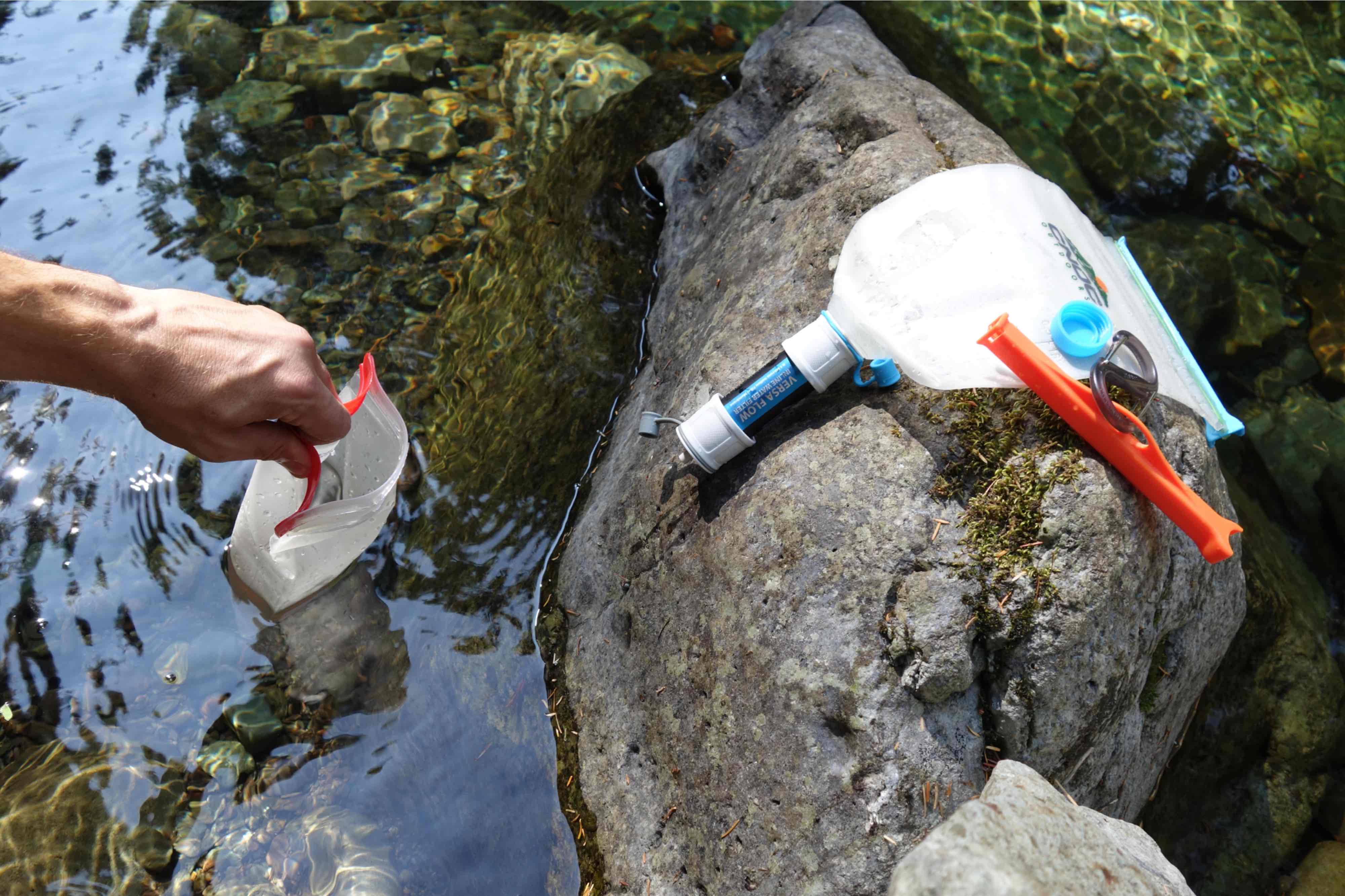
When we put out the call for vendors, my college classmate Lauren Hudgins asked if the company she works for would be a good fit. We like to have at least one gadget to show off at the event that isn’t strictly handmade, and she got this year’s slot. Cnoc’s portable water bags that fit many filters seem like a lightweight boon for bikepackers and tourers—come check one out.
What are you bringing to BikeCraft? What’s the most important thing people should know about it?
We’re bringing Vectos [ https://ift.tt/2FNzIPL ]: foldable water containers designed in Portland that connect to Sawyer filters, or a HydroBlu Versa Flow, or a LifeStraw Flex. We’ll also have gravity filtering systems that come with a HydroBlu Versa Flow. When you’re bike packing or bike touring being able to produce safe water from whatever sources are available can be critical.
Tell us about yourself—what events in your life led you to be doing this bikey craft?
Gilad Nachmani began Cnoc Outdoors a couple years ago as a way to produce the hiking gear he needed but couldn’t find on the market. I’m coming in as a cyclist who has done a lot of bike camping and sees the benefit of the Vecto for bike packing or bike touring.
The Sprockettes – website
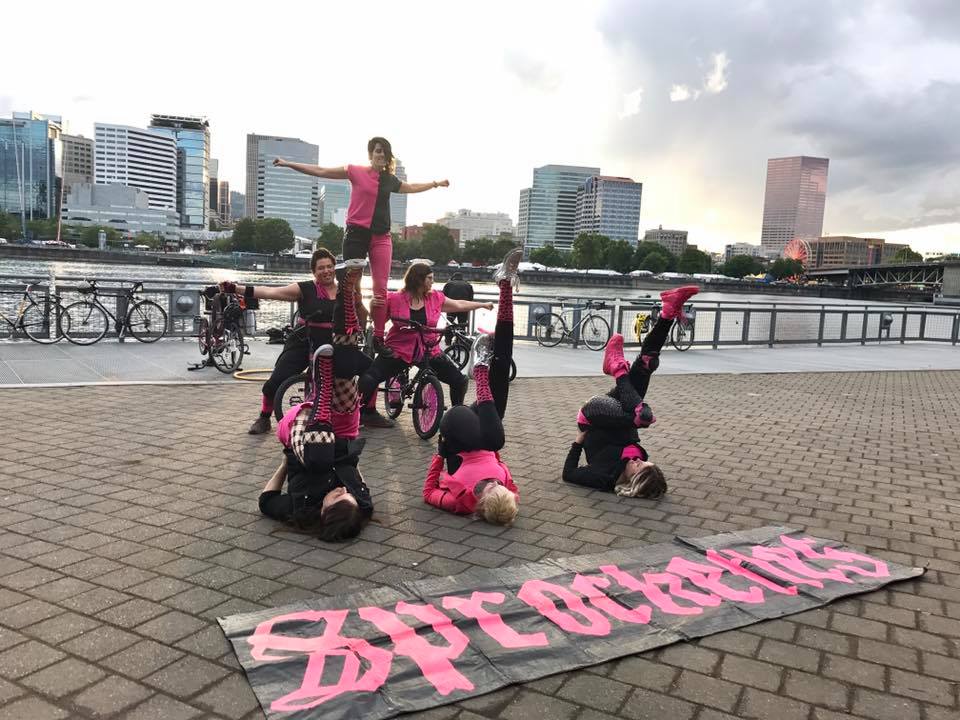
Portland’s original all-women mini-bike dance troupe hardly needs an introduction in these pages. We asked the Sprockettes to be a part of BikeCraft this year not as performers but in their community engagement role: They’ll be running a helmet decorating station for kids (of all ages!), as well as slinging their own merch.
What are you bringing to BikeCraft? What’s the most important thing people should know about it?
We are bringing handmade Sprockettes merchandise including jewelry, patches, magnets, and all kinds of crafty materials for a bike helmet decoration station.
Tell us about yourself—what events in your life led you to be doing this bikey craft?
The Sprockettes are a DIY Mini Bike Dance Team, it only seemed natural to make our own bikey merch. As performers, we incorporate BMX bikes in choreography by exploring their uses as dance partner and prop. Since founding The Sprockettes in 2004, we have seen more than 40 member Agents grace the performance stage and add to the bike dance creativity. For nearly 10 of those years we have been hosting a Girls’ Summer Camp, where we train little Spockettes in acro-balancing, bike tricks, and dance, culminating in a performance at the end of a 2 day camp. It is so amazing to see our little Sprockettes gain confidence with their bikes! As part of performance preparation we spend time decorating our bikes, and for BikeCraft, we will host helmet decoration!
What’s your favorite BikeCraft memory?
We are super excited to see the bike helmet creations of participants! We also want to help teach best bike helmet wearing practices to all sizes of bikers.
Learn more about BikeCraft at the official website.
— Elly Blue/Microcosm Publishing
Never miss a story. Sign-up for the daily BP Headlines email.
BikePortland needs your support.
The post BikeCraft vendor spotlights: Drew Devereux, CNOC Outdoors, Sprockettes appeared first on BikePortland.org.
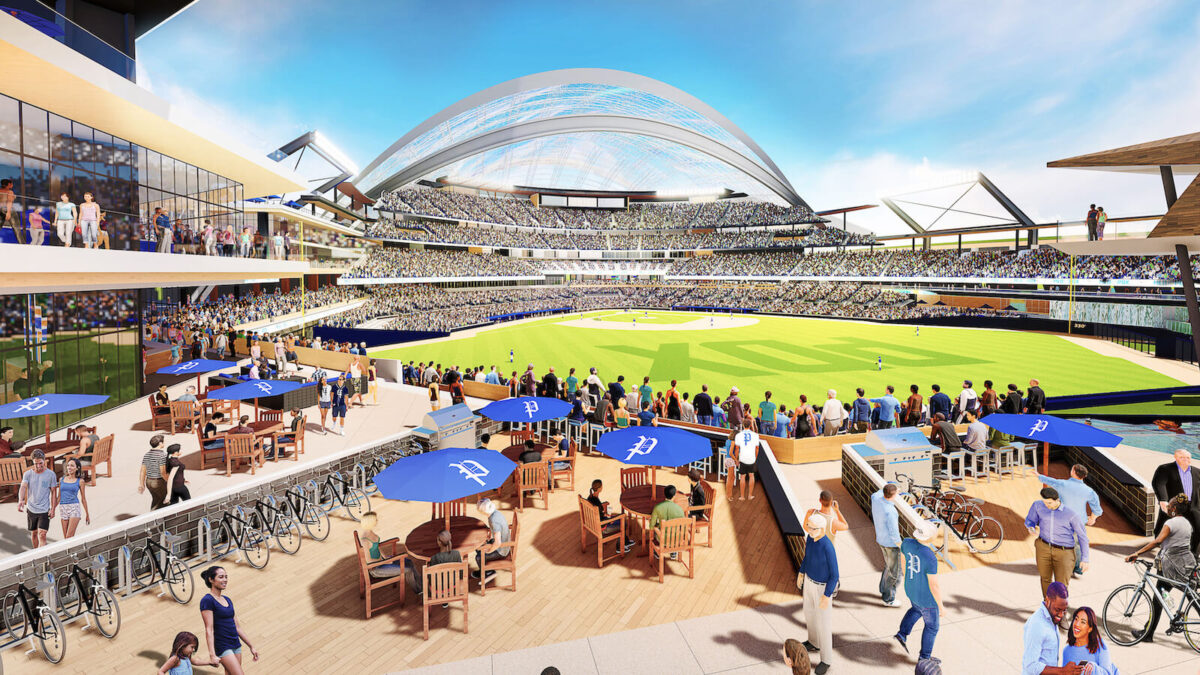
Portland Diamond Project used this as their lead image and titled it on their website as “Bike Tailgating.”
In Portland you can’t propose a Major League Baseball stadium without putting bikes front and center.
Yesterday a consortium of financiers, celebrities, and fans made a big splash with an announcement about a potential site for a future franchise in Portland.
“We absolutely do take transportation seriously. We expect a lot to be invested in infrastructure.”
— John McIsaac, Portland Diamond Project
The Portland Diamond Project says they’ve inked an agreement with the Port of Portland to develop a stadium on Terminal 2, a 50-acre parcel of industrial land along the Willamette River in northwest Portland about one mile north of the Fremont Bridge.
Along with announcement the group released several renderings of the stadium. The main image, titled “Bike Tailgating,” features over a dozen bicycles prominently parked in the foreground.
This has us wondering: If this project moves forward (a big if, given it would cost billions to not build the stadium and an MLB franchise), how would people get to the games?
As it sits right now, the T2 site is basically a transportation desert. Unless you’re in a car. It’s served by just one infrequent TriMet bus line (16) and it’s over a mile away from a Portland Streetcar stop. Even with their planned northwest expansion a stop would still be about a half-mile away. Light rail is much too far away at about 1.5 miles and a MAX expansion in this area isn’t even on the table.
And who knows, maybe the nascent Frog Ferry would add a stop at the stadium.
As for bikes, some of the parcel is actually inside the current Biketown bike share service area. But the wide roads around T2 would be frightening for the average bicycle user to ride on. In April 2016 during our NW Portland Week, I shared two posts that offer an in-depth look at cycling in the area. To recap: There’s tons of cycling potential on NW Front Avenue. We could use the 80-90 foot wide cross-sections to build physically protected bike lanes and make a direct connection to downtown.
There are already positive signs for Front Avenue. In May we reported that a developer paid out-of-pocket for a Biketown station for an office property on NW 17th (the T2 site is further north at around 26th). That same developer also chipped in over $1 million to help the Bureau of Transportation build street upgrades that include protected bike lanes.
If this stadium is ever built, there’s also a question of how it would impact the Willamette Greenway Trail. Developers would be on the hook to create public riverfront access; but how and if cycling is integrated into it would be a big question mark.
Given the growth trajectory of the NW Front Avenue corridor, it’s safe to say street updates and bikeways will be built by the time any new stadium becomes a reality. Years down the road, it’s also reasonable to assume TriMet will have better bus service here as well.
But would taxpayers be on the hook for getting baseball fans to a privately-owned stadium? Mayor Ted Wheeler has said he won’t support public subsidy for this project; but he might not be in office by the time this issue boils over.
For their part, Portland Diamond Project spokesperson John McIsaac told me this morning, “We absolutely must take transportation seriously, and we absolutely do.”
However, at this stage in the game, it’s clear they’ve focused all their efforts in politics and fundraising. Asked if they’d talked to PBOT yet, McIsaac said they planned to do so today. The Oregonian reported yesterday that they haven’t yet talked to TriMet about the T2 site.
Asked if they were prepared to spend on transportation, McIsaac shared with me via email that, “We expect a lot to be invested in infrastructure.”
— Jonathan Maus: (503) 706-8804, @jonathan_maus on Twitter and jonathan@bikeportland.org
Never miss a story. Sign-up for the daily BP Headlines email.
BikePortland needs your support.
The post Riverfront stadium proposal raises questions about transportation access appeared first on BikePortland.org.
We had two job listings posted this week. Learn more about each one via the links below…
–> Director of Bureau Planning and Sustainability – City of Portland
–> Mechanic Part or Full Time Seasonal – RecumbentPDX
For a complete list of available jobs, click here.
Be the first to know about new job opportunities by signing up for our daily Job Listings email or by following @BikePortland on Twitter.
These are paid listings. And they work! If you’d like to post a job on the Portland region’s “Best Local Blog” two years running, you can purchase a listing online for just $75. Learn more at our Job Listings page.
— Jonathan Maus: (503) 706-8804, @jonathan_maus on Twitter and jonathan@bikeportland.org
Never miss an opportunity. Sign up for our Job Listings email.
BikePortland needs your support.
The post Jobs of the Week: City of Portland BPS, RecumbentPDX appeared first on BikePortland.org.
A new program from the Portland Bureau of Transportation has quietly emerged as the agency’s latest attempt to make progress on our deadliest streets.
I stumbled across the East Portland Arterial Streets Strategy (EPASS) while on PBOT’s website a few weeks ago and have now learned a bit more about what we can expect from it.
Here’s the background: PBOT has significant plans and funding ($255 million allocated to the East Portland in Motion plan) devoted to taming east Portland arterials. But progress is painfully slow. 15 of the 32 people who’ve died in traffic crashes so far this year were using streets east of 82nd Avenue.
In an effort to consolidate and hasten the 15 projects currently in progress or in the pipeline — and do a better job communicating changes to residents and business owners — PBOT says they plan to develop a concept design for every city street with four or more lanes east of 82nd Avenue. The designs will answer questions about how many driving lanes a street should have, what type of bike lanes, transit lanes, and medians are appropriate, how best to manage curb cuts, turning movements, and so on. The designs will be based on community input, safety analysis and traffic modeling.
According to PBOT, they created EPASS to answer concerns they’ve heard from east Portland residents about how planned projects will impact surrounding streets. Fears that road diets will lead to more cut-through traffic in neighborhoods is a very common concern. Asked about the impetus for EPASS, a PBOT spokesperson told us, “If we’re reducing lanes on multiple streets in the same area, can we do that without delay and diversion onto other streets that would impact the community?”
One of PBOT’s challenges in their work east of 82nd is that they’re re-allocating road space on arterials and simultaneously trying to develop “low-stress, family-friendly” neighborhood greenways that meet their standards for auto traffic volumes.
This is also a public relations move that will aid PBOT’s communications strategy. The agency says they want to take a, “more holistic look at the package of projects coming to east Portland and provide the community with a more comprehensive picture of the improvements and impacts coming their way.”
PBOT plans to identify a few new projects that could be eligible for future funding. Road segments they plan to address for the first time through EPASS include: SE Foster from 101st to 122nd; NE Glisan between 82nd and 102nd; and NE Sandy from 82nd to I-205.
EPASS is not to be confused with PBOT’s existing High Crash Network program, which doesn’t get into detailed cross-section designs. PBOT says we should think of EPASS as being similar to a technical design guide focused specifically on streets with four or more lanes.
The effort will be carried out by Portland-based consulting firm HDR Inc. (working with city staff) via $265,000 in PBOT general operating funds.
If you’d like to learn more, check out the official website. You can also meet EPASS Project Manager Steve Szigethy at the December 12th meeting of the East Portland Land Use and Transportation Committee.
— Jonathan Maus: (503) 706-8804, @jonathan_maus on Twitter and jonathan@bikeportland.org
Never miss a story. Sign-up for the daily BP Headlines email.
BikePortland needs your support.
The post PBOT has a new strategy to tame east Portland’s deadly arterials appeared first on BikePortland.org.

Old, exposed rails on NW 15th Avenue are just one of many barriers to biking in northwest PBOT wants to remove.
(Photo: Jonathan Maus/BikePortland)
The Portland Bureau of Transportation has released a list of 20 projects they’d like to build in northwest Portland and now it’s your turn to visit the online open house and give them feedback.
The list emerged from PBOT’s Northwest in Motion (NWIM) planning process that we first profiled back in May. The 20 projects include 10 neighborhood greenways, seven “corridor safety” projects, and three transit line improvements (view interactive project map below the jump). Similar to their approach with Central City in Motion (which passed City Council earlier this month) and Southwest in Motion (which has an open house tonight), PBOT says the aim of this process is to identify and develop projects they can fund and build in the next five years.
Below are two PBOT maps. The first one shows existing and funded bikeways in the NWIM project area. The second one shows all the proposed NWIM projects (“CS” is corridor safety, “TI” is transit improvement, and “NG” is neighborhood greenway):
Once the project list is finalized, it will be easier for PBOT to funnel parking revenue and other funding sources to them.
In addition to the project list, PBOT is also using this opportunity to change the roadway classification of some streets. Classifications are important planning designations that often dictate what types of treatments PBOT can use. PBOT has three main cycling designations that make up what they call a “functional hierarchy of bikeway routes”: Local Service Bikeways (for circulation within a neighborhood), City Bikeways (principal routes), and Major City Bikeways (the “backbone” of our bike network).
*Interactive map of NWIM projects.
In NWIM, PBOT is proposing to downgrade Overton, Thurman and Raleigh from City Bikeways to Local Service Bikeways. This change would come with a promise to upgrade Savier and Pettygrove into modern neighborhood greenways. On NW Savier for instance, the proposal is to add speed bumps and sharrows, turn stop signs, and install bikeway signage between 14th to 29th. Other updates include addition of auto traffic diverters, removal of old railroad rails in the pavement on NW 15th, and other changes. Once implemented, PBOT would remove sharrows on Raleigh which is one block south. A similar swap of upgrades and subsequent removal of sharrows would happen on Pettygrove and Overton.
Another key project would be an update to NW Johnson, a crucial east-west connection through this part of the city. PBOT wants to add all the greenway trimmings to Johnson between 9th and 24th and repave the bumpy spots.
A completely new neighborhood greenway is proposed for NW 22nd. It would create a bike street between NW Savier and SW Salmon that would include a safe crossing of Burnside via SW King Ave.
As we discovered during our NW Portland Week, given its density and street grid NW Portland has vast potential for biking. Currently just eight percent of residents ride to work and 44 percent drive alone — despite the fact that PBOT estimates show 37 percent of all auto trips in northwest are less than three miles.
If you live, work, or play in this area, please visit the online open house and help PBOT prioritize investments and make these projects better. The open house will be available through December 13th.
The project list is expected to be finalized by early 2019 and an investment strategy should be passed by city council by this coming spring.
— Jonathan Maus: (503) 706-8804, @jonathan_maus on Twitter and jonathan@bikeportland.org
Never miss a story. Sign-up for the daily BP Headlines email.
BikePortland needs your support.
The post With eyes on less driving, Portland unveils 20 ‘Northwest in Motion’ projects appeared first on BikePortland.org.
50 years after a Portland State University professor helped spark a statewide cycling movement, a new sculpture will be erected to celebrate his work.
“This artwork will create a place for the people and the policies that allow Oregonians to go by bike across our beautiful state.”
— Oregon Environmental Council
In 1971 the Oregon State Legislature passed a bill mandating a minimum of 1 percent of state highway project funds be used for cycling and walking infrastructure. The “Bike Bill” (ORS 366.541) as it became known, was signed on the capitol steps from the seat of a bicycle by then Governor Tom McCall.
In 1995, the Bike Bill was used by The Street Trust (then the Bicycle Transportation Alliance) in their successful lawsuit against the the City of Portland, and it remains an important tool that helps us hold the Oregon Department of Transportation accountable for building a system that serves more than just automobile users.
A PSU professor named Sam Oakland was the bike advocate who persuaded lawmakers to pass it. He was an outspoken critic of the automobile onslaught, founder of Portland’s Bike Lobby group and the first chair of the City of Portland’s Bicycle Path Task Force — the committee that developed our first bicycle plan in 1973. (Oakland passed away at the age of 80 back in 2014.)
Now Oakland’s work will be remembered with a piece of public art to be dedicated later this winter.
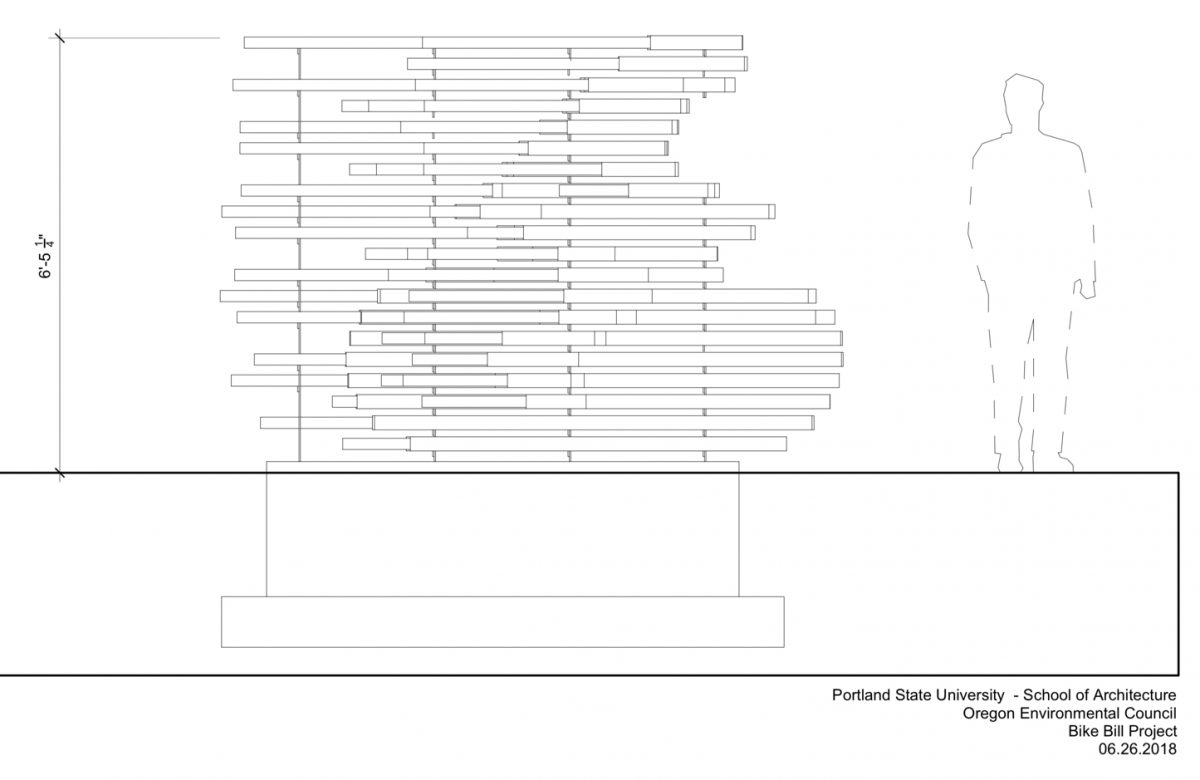
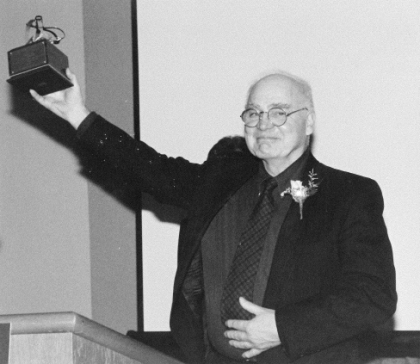
Sam Oakland in 2001 when he received a lifetime achievement award from The Street Trust.
(Photo: The Street Trust)
The Oregon Environmental Council is behind the project. It’s one of three such “Art of Loving Oregon” projects they’ve undertaken to commemorate their 50th anniversary. The other two are the “Bottle Bill” that spurred recycling and the Oregon law that laid the foundation for our state’s anti-sprawl and farmland preservation regulations.
Dubbed, “Anthropocene” (a term for our current geological age that’s defined by human impacts) the six-and-a-half foot tall sculpture created by PSU School of Architecture students (overseen by Aaron Whelton) will be erected on the southwest corner of SW 10th and Harrison, just across the street from the Millar Library on the PSU campus.
According to sketches provided to BikePortland, the somewhat abstract sculpture will be just over nine feet long and two feet wide. A series of two-inch diameter pipes separated by half-inch thick steel plates will create an outline of a bicycle and its rider in motion.
Here’s how OEC’s Kevin Kasowski describes it:
“The idea is a bit hard to capture in one image… it is designed so that from most perspectives, it looks like a random collection of pipes but when you stand at a side view the silhouette of the biker and bike emerges.”
A statement from the OEC says the installation will, “create a place for the people and the policies that allow Oregonians to go by bike across our beautiful state.”
Stay tuned for details on the dedication ceremony event and photos after it’s installed.
— Jonathan Maus: (503) 706-8804, @jonathan_maus on Twitter and jonathan@bikeportland.org
Never miss a story. Sign-up for the daily BP Headlines email.
BikePortland needs your support.
The post New sculpture in downtown Portland will celebrate Oregon’s ‘Bike Bill’ appeared first on BikePortland.org.
It may not be as cold as it could get in winter yet, but now’s the perfect time to start drilling down the habit of saving electricity when you can. Prepare a list of things you should do before winter fully sets in and don’t forget to include the following:
 Photo by Thomas Kelley on Unsplash
Photo by Thomas Kelley on Unsplash
If you have rooms that you never use, like guest rooms or large storage areas, close and seal off the vents in those rooms to be more energy efficient and direct the flow of air to the rooms you use most. Energy bills run, on average, $183 per month. By using a space heater in the rooms where you need it and setting the thermostat to 62 degrees, you can save approximately $200 each year. Source: Money.USNews
Cover up the attic entry with plastic, pieces of insulation, old blankets, weather stripping, saran wrap, painter drop cloth, or even a few old shirts. Any of it will help to slow, if not, stop, the drafts and warm air from floating away through your roof. Heat rises and may be getting pulled right up through the attic so you may not notice a cold draft even though your expensive hot air is floating away. Source: TheBalance
A couple degrees cooler when you’re away or asleep can make a big difference on your heating bill (without any sacrifice from you).
Tip: Get a programmable thermostat, and let it make the adjustments for you. Source: TheSpruce
Considering water heating costs account for 11 percent of your utility bills, switching out your water heater can drastically cut energy bills, according to This Old House. Consider gas and solar options, many of which are tankless to maximize efficiency.
“Traditional water heaters maintain a full tank of warm water, which requires constant energy to keep warm,” said Than Merrill, founder and CEO of the real estate investment education company FortuneBuilders. “Tankless water heaters, on the other hand, only heat water on demand. That way, you do not have the extra energy consumption occurring when hot water is not being used.” Source: Time
Carpet can provide good insulation for your floors, especially if you choose the thicker type with underlay. Give us a call and we can help you pick a carpet that would be perfect for your home all year-round.
The post Ways to Lower Energy Bills during Fall appeared first on Curlys Carpet Repair.
A coalition with concerns over the State of Oregon’s planned $450 million expansion of Interstate 5 through Portland’s Rose Quarter have requested more time to consider the project’s environmental impacts.
“We believe that the proposed thirty day public comment period is inadequate for us to meaningfully review the disclosed materials.”
– No More Freeways coalition
The Oregon Department of Transportation (ODOT) expects to release the findings of their federally-mandated Environmental Assessment (EA) of the I-5 Rose Quarter project in January. That document typically comes with a 30-day public comment period. The No More Freeways coalition — a grassroots group fighting the project — sent a letter (below) to ODOT this morning requesting an additional 60 days.
The letter, signed by 31 representatives from social justice, public health, environmental, and transportation advocacy groups, said 30 days is, “inadequate for us to meaningfully review the disclosed materials, assess the findings about air quality and congestion, and provide thoughtful feedback about this project’s impacts.” The letter also says given that the comment period will likely overlap with two federal holidays, the comment period could end up resulting in as few as 18 business days to provide feedback.
This isn’t the first time ODOT has heard concerns about this issue.
Back in March, ODOT’s decision to conduct only an EA instead of the more rigorous Environmental Impact Statement resulted in a Freedom of Information Act request by a local environmental law firm on behalf of the Audubon Society and OPAL Environmental Justice Oregon. ODOT defends their move by saying the EA is the middle of the three National Environmental Protection Act (NEPA) reports required for projects like this and that it’s the appropriate tool to use when likely negative impacts can be mitigated. An EIS is only necessary, ODOT contends, when negative impacts can’t be reduced or avoided. (Interestingly, this section of I-5 has never had a full EIS because it was constructed before the NEPA process was created.)
Then in July, Metro Councilor Bob Stacey put ODOT on notice when he said their approach to the NEPA process wouldn’t adequately vet community concerns around the project.
Earlier this month, members of the Portland Bureau of Transportation Bicycle Advisory Committee again questioned an ODOT project manager on this issue. BAC Member Sarah Iannorone asked ODOT’s Meghan Channel (on hand to share an update on bicycling and walking plans in the project) if she thought 30 days was long enough. “30 days is the standard for a federal project,” Channel replied. When Iannarone followed-up to say Portland should to exceed federal standards, Channel said ODOT would entertain the idea of a longer comment period if a formal request was made.
In addition to a longer comment period, No More Freeways has requested a public open house to be held in the neighborhoods adjacent to the planned project. “We are requesting a 60-day extension, and an opportunity for community members to deliver oral testimony in a public hearing,” states their letter, “Anything less would represent a failure of civic commitment to democratic principles to allow the community to appropriately understand ODOT’s project in their neighborhood.”
Air quality around Tubman Middle School, which is just yards away from where one of the new freeway lanes will be added, will be one aspect of the EA that will get a lot of attention.
After the comment period on the EA concludes, ODOT plans to begin design of this project in spring 2019.
— Jonathan Maus: (503) 706-8804, @jonathan_maus on Twitter and jonathan@bikeportland.org
Never miss a story. Sign-up for the daily BP Headlines email.
BikePortland needs your support.
The post No More Freeways coalition requests more time for I-5 expansion project feedback appeared first on BikePortland.org.
BikePortland supporter and contributor Kiel Johnson (owner of the Go By Bike valet) has been working to create more support for a neighborhood greenway on 7th Avenue as part of PBOT’s Lloyd-to-Woodlawn project. This is his latest post in a series.
You don’t need to change the world to make a difference.
That’s what I’ve learned from these past few months of hunkering down on my advocacy for a NE 7th Avenue neighborhood greenway. If built as proposed, the project would transform 7th — from I-84 to Woodlawn — into a street where safety of all users is the priority.
I feel a little more at home on my street and it is a little better already — even without a greenway.
When we last left off, my wife and I had just finished hosting an ice cream social to talk with our neighbors about the project. We knocked on every door from Thompson to Alberta, talking to anyone who opened the door and trying our hardest to make everyone feel welcome to attend, regardless of their position on the project. Over 50 people showed up.
But I was disappointed. My neighbors who’ve expressed serious concerns about this project to PBOT, didn’t attend. So I went out to have a conversation with them.
I got in touch with Ronnie Herndon, the leader of Albina Head Start who was quoted in a Skanner News article, saying he is, “watching the project like a hawk.” From our meeting I learned that Mr. Herndon is a pretty great guy. His life has been one of fighting for racial and economic justice for our community. Ronnie has a picture of Martin Luther King Jr and Malcolm X shaking hands hanging over his desk.
We chatted in his office at the Albina Head Start on NE 7th and Fremont for a hour. (My dad had worked in Head Start in Seattle in the 1990s and Ronnie told me they’d probably met at some point.) We found we agreed about everything except this project. At the very end we both explained our position on the greenway. He is concerned that it will be another impediment for people accessing his services. I acknowledge that it will make it harder for people to drive, but in my opinion the tradeoff in safety is worth it. We listened to each other and I left feeling like I had met someone who I would like to aspire to.
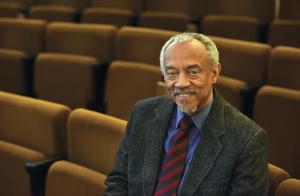
Ronnie Herndon
(Photo: Multnomah County)
One thing Ronnie told me was that, when you advocate for something, make the process of advocating help accomplish your goal. With this in mind I began thinking about what to do next.
I want the street I live on to be a place that has identity and is interesting to be on. How could my advocacy help create that?
Seven years ago I made a friend from Couchsurfing who lives in (and is from) Mexico. We see each other a couple times a year and have travelled together in Seattle, San Fransisco, Copenhagen, and Sweden. She is a tactical urbanist in her city of La Paz in Southern Baja. She suggested that I make custom yard signs and decorate them. I went to SCRAP, spent $10 on used yard signs, made some stencils, and spray painted a few signs. I then put a free yard sign pile outside our house and encouraged people to take one. I also encouraged people to customize their sign as well.
All the signs are unique in some way with different characters and colors, which makes for something interesting to look at. In my opinion they help make the street stand out more and help give it some identity. It has also helped to unite the many people who are concerned about the current state of safety on 7th. There are over 20 signs out there today. If you get a chance in the next week come walk up and down NE 7th and experience what it is like and see if you can find all the signs.
I signed up to testify to City Council this morning about the project and deliver the petition that was started by some of my neighbors. If you’d like to help me get it over the 1,000 mark it would be much appreciated!
No matter what Mayor Wheeler and our commissioners say at City Hall today I feel a little more at home on my street and it is a little better already — even without a greenway. And for me, that makes this all worth it. Stay tuned for what comes next.
— Kiel Johnson @go_by_bike on Twitter
Never miss a story. Sign-up for the daily BP Headlines email.
BikePortland needs your support.
The post Activism insight: You don’t need to change the world to make a difference appeared first on BikePortland.org.